Blog & Latest Updates
Fly Fishing Articles
Insects by Common Name


Animal Phylum Arthropoda (Arthropods)
Taxonomic Navigation -?-
Kingdom
Animalia (Animals)
» Phylum Arthropoda (Arthropods)
| Class in Arthropoda | ||
| ArachnidaMites and Spiders | 0 | 1 |
| CollembolaSpringtails | 0 | 0 |
| Crustacea-MalacostracaCrayfish, Scuds, and Sowbugs | 0 | 10 |
| Crustacea-Maxillopoda | 0 | 0 |
| InsectaInsects | 0 | 114 |
Common Name
| Match | Common Name |
| Arthropods |
This is page 12 of specimens of Arthropoda. Visit the main Arthropoda page for:
- The behavior and habitat of Arthropoda.
- 122 underwater pictures of Arthropoda.
Pictures of 1244 Arthropod Specimens:
Isoperla (Stripetails and Yellow Stones) Stonefly Adult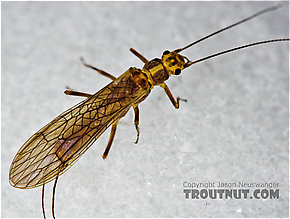 View 10 PicturesSeveral stoneflies of this species were flying around a small stream last night. I tied on a brown drake imitation of about the right size/color to approximate these stones, and was rewarded with a hard-fighting 17-inch brown trout.
View 10 PicturesSeveral stoneflies of this species were flying around a small stream last night. I tied on a brown drake imitation of about the right size/color to approximate these stones, and was rewarded with a hard-fighting 17-inch brown trout.
 View 10 PicturesSeveral stoneflies of this species were flying around a small stream last night. I tied on a brown drake imitation of about the right size/color to approximate these stones, and was rewarded with a hard-fighting 17-inch brown trout.
View 10 PicturesSeveral stoneflies of this species were flying around a small stream last night. I tied on a brown drake imitation of about the right size/color to approximate these stones, and was rewarded with a hard-fighting 17-inch brown trout.Collected July 7, 2006 from Cayuta Creek in New York
Added to Troutnut.com by Troutnut on July 8, 2006
Added to Troutnut.com by Troutnut on July 8, 2006
Ephemerella (Hendricksons, Sulphurs, PMDs) Mayfly Nymph View 6 PicturesThis pretty Ephemerella nymph has really weird markings. It has one band on the tibiae (
View 6 PicturesThis pretty Ephemerella nymph has really weird markings. It has one band on the tibiae ( Tibia: A middle segments in the leg of an insect, located between the femur and the tarsus.) and a thin but distinct dorsal (Dorsal: Top.) stripe faded in the center which looks very different from the stripes on Ephemerella needhami and Ephemerella aurivillii. It definitely has the fan tail characteristic of the Ephemerella genus.
Tibia: A middle segments in the leg of an insect, located between the femur and the tarsus.) and a thin but distinct dorsal (Dorsal: Top.) stripe faded in the center which looks very different from the stripes on Ephemerella needhami and Ephemerella aurivillii. It definitely has the fan tail characteristic of the Ephemerella genus.
 View 6 PicturesThis pretty Ephemerella nymph has really weird markings. It has one band on the tibiae (
View 6 PicturesThis pretty Ephemerella nymph has really weird markings. It has one band on the tibiae (
The tibia of this Isonychia bicolor mayfly spinner is highlighted in red.
Collected February 7, 2004 from unknown in Wisconsin
Added to Troutnut.com by Troutnut on January 25, 2006
Added to Troutnut.com by Troutnut on January 25, 2006
Paraleptophlebia (Blue Quills and Mahogany Duns) Mayfly Nymph View 6 Pictures
View 6 Pictures
 View 6 Pictures
View 6 PicturesCollected February 7, 2004 from unknown in Wisconsin
Added to Troutnut.com by Troutnut on January 25, 2006
Added to Troutnut.com by Troutnut on January 25, 2006
Nigronia serricornis (Fishfly) Hellgrammite Larva View 5 Pictures
View 5 Pictures
 View 5 Pictures
View 5 PicturesCollected January 14, 2004 from unknown in Wisconsin
Added to Troutnut.com by Troutnut on January 25, 2006
Added to Troutnut.com by Troutnut on January 25, 2006
Hydropsyche (Spotted Sedges) Caddisfly Pupa View 8 PicturesSeveral users have interesting comments in the discussion of this specimen, but this observation by Creno is especially good:
View 8 PicturesSeveral users have interesting comments in the discussion of this specimen, but this observation by Creno is especially good:
 View 8 PicturesSeveral users have interesting comments in the discussion of this specimen, but this observation by Creno is especially good:
View 8 PicturesSeveral users have interesting comments in the discussion of this specimen, but this observation by Creno is especially good:Also, this is what I would call an "immature" pupa. The wingpads of caddis pupae darken to nearly black as the enclosed adults near emerging. The darkening is the developing adult wing inside the pupal wing pad (Wing pad: A protrusion from the thorax of an insect nymph which holds the developing wings. Black wing pads usually indicate that the nymph is nearly ready to emerge into an adult.). The ultimate coloration of the adult wing is not very apparent in most pupal wing pads ( The wing pads on this final instar Baetidae mayfly nymph are extremely dark.Wing pad: A protrusion from the thorax of an insect nymph which holds the developing wings. Black wing pads usually indicate that the nymph is nearly ready to emerge into an adult.) as the majority of the adult wing coloration comes from the color/position of the adult wing hairs and setae (Seta: Little hairs on insects.). But dark pupal wingpads are a good indication that the emergence will occur very soon, likely that day or so, and that the adult parts are sufficiently developed within the pupae to make a species determination from the specimen, particularly if it is a male.
The wing pads on this final instar Baetidae mayfly nymph are extremely dark.Wing pad: A protrusion from the thorax of an insect nymph which holds the developing wings. Black wing pads usually indicate that the nymph is nearly ready to emerge into an adult.) as the majority of the adult wing coloration comes from the color/position of the adult wing hairs and setae (Seta: Little hairs on insects.). But dark pupal wingpads are a good indication that the emergence will occur very soon, likely that day or so, and that the adult parts are sufficiently developed within the pupae to make a species determination from the specimen, particularly if it is a male. The wing pads on this final instar Baetidae mayfly nymph are extremely dark.
The wing pads on this final instar Baetidae mayfly nymph are extremely dark.
Collected May 13, 2007 from the Delaware River in New York
Added to Troutnut.com by Troutnut on May 18, 2007
Added to Troutnut.com by Troutnut on May 18, 2007
Rheotanytarsus Midge Larva View 6 PicturesThis peculiar midge lived in a case tightly fixed to a rock, with several others of its kind. The case seems to be made of tiny grains of sand. I'm not sure what the function is for the little lines sticking out the front, because they aren't legs.
View 6 PicturesThis peculiar midge lived in a case tightly fixed to a rock, with several others of its kind. The case seems to be made of tiny grains of sand. I'm not sure what the function is for the little lines sticking out the front, because they aren't legs.
 View 6 PicturesThis peculiar midge lived in a case tightly fixed to a rock, with several others of its kind. The case seems to be made of tiny grains of sand. I'm not sure what the function is for the little lines sticking out the front, because they aren't legs.
View 6 PicturesThis peculiar midge lived in a case tightly fixed to a rock, with several others of its kind. The case seems to be made of tiny grains of sand. I'm not sure what the function is for the little lines sticking out the front, because they aren't legs.Collected April 14, 2007 from Cayuta Creek in New York
Added to Troutnut.com by Troutnut on April 22, 2007
Added to Troutnut.com by Troutnut on April 22, 2007
Paragnetina immarginata (Beautiful Stonefly) Stonefly Adult View 9 Pictures
View 9 Pictures
 View 9 Pictures
View 9 PicturesCollected May 29, 2007 from Brodhead Creek in Pennsylvania
Added to Troutnut.com by Troutnut on June 4, 2007
Added to Troutnut.com by Troutnut on June 4, 2007
Argia Damselfly Nymph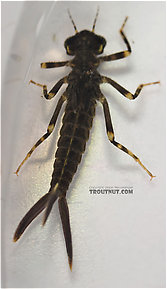 View 3 PicturesMy friend Willy captured this early instar (Instar: Many invertebrates molt through dozens of progressively larger and better-developed stages as they grow. Each of these stages is known as an instar. Hard-bodied nymphs typically molt through more instars than soft-bodied larvae.) damselfly nymph and brought it to me for identification. It is more robust and stocky at this early stage than the spindly appearance of the later instars (Instar: Many invertebrates molt through dozens of progressively larger and better-developed stages as they grow. Each of these stages is known as an instar. Hard-bodied nymphs typically molt through more instars than soft-bodied larvae.), and its appearance is less familiar.
View 3 PicturesMy friend Willy captured this early instar (Instar: Many invertebrates molt through dozens of progressively larger and better-developed stages as they grow. Each of these stages is known as an instar. Hard-bodied nymphs typically molt through more instars than soft-bodied larvae.) damselfly nymph and brought it to me for identification. It is more robust and stocky at this early stage than the spindly appearance of the later instars (Instar: Many invertebrates molt through dozens of progressively larger and better-developed stages as they grow. Each of these stages is known as an instar. Hard-bodied nymphs typically molt through more instars than soft-bodied larvae.), and its appearance is less familiar.
 View 3 PicturesMy friend Willy captured this early instar (Instar: Many invertebrates molt through dozens of progressively larger and better-developed stages as they grow. Each of these stages is known as an instar. Hard-bodied nymphs typically molt through more instars than soft-bodied larvae.) damselfly nymph and brought it to me for identification. It is more robust and stocky at this early stage than the spindly appearance of the later instars (Instar: Many invertebrates molt through dozens of progressively larger and better-developed stages as they grow. Each of these stages is known as an instar. Hard-bodied nymphs typically molt through more instars than soft-bodied larvae.), and its appearance is less familiar.
View 3 PicturesMy friend Willy captured this early instar (Instar: Many invertebrates molt through dozens of progressively larger and better-developed stages as they grow. Each of these stages is known as an instar. Hard-bodied nymphs typically molt through more instars than soft-bodied larvae.) damselfly nymph and brought it to me for identification. It is more robust and stocky at this early stage than the spindly appearance of the later instars (Instar: Many invertebrates molt through dozens of progressively larger and better-developed stages as they grow. Each of these stages is known as an instar. Hard-bodied nymphs typically molt through more instars than soft-bodied larvae.), and its appearance is less familiar.Collected August 28, 2005 from Fall Creek in New York
Added to Troutnut.com by Troutnut on April 14, 2006
Added to Troutnut.com by Troutnut on April 14, 2006
Maccaffertium ithaca (Light Cahill) Mayfly Dun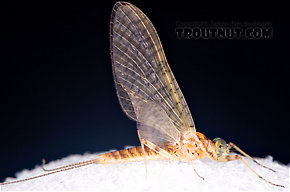 View 9 PicturesThis dun emerged from a nymph in one of the bowls on my table while I was sorting. I photographed it with the nymphal shuck (
View 9 PicturesThis dun emerged from a nymph in one of the bowls on my table while I was sorting. I photographed it with the nymphal shuck (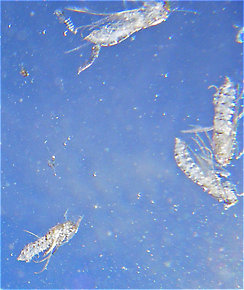 Shuck: The shed exoskeleton left over when an insect molts into its next stage or instar. Most often it describes the last nymphal or pupal skin exited during emergence into a winged adult.), and it seems to be of the same species as a nymph I photographed from the same sample.
Shuck: The shed exoskeleton left over when an insect molts into its next stage or instar. Most often it describes the last nymphal or pupal skin exited during emergence into a winged adult.), and it seems to be of the same species as a nymph I photographed from the same sample.
 View 9 PicturesThis dun emerged from a nymph in one of the bowls on my table while I was sorting. I photographed it with the nymphal shuck (
View 9 PicturesThis dun emerged from a nymph in one of the bowls on my table while I was sorting. I photographed it with the nymphal shuck (
Here's an underwater view of the pupal shucks of several already-emerged Brachycentrus numerosus caddisflies.
Collected May 29, 2007 from Paradise Creek in Pennsylvania
Added to Troutnut.com by Troutnut on June 4, 2007
Added to Troutnut.com by Troutnut on June 4, 2007
Ephemera simulans (Brown Drake) Mayfly Nymph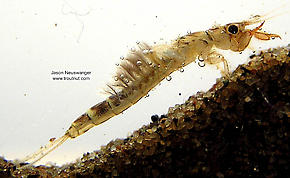 View 6 Pictures
View 6 Pictures
 View 6 Pictures
View 6 PicturesCollected January 31, 2004 from the Namekagon River in Wisconsin
Added to Troutnut.com by Troutnut on January 25, 2006
Added to Troutnut.com by Troutnut on January 25, 2006
Top 10 Fly Hatches
Top Gift Shop Designs
Eat mayflies.
Top Insect Specimens
Miscellaneous Sites
Troutnut.com is copyright © 2004-2024 Jason
Neuswanger (email Jason). See my FAQ for information about use of my images.
 privacy policy
privacy policy
